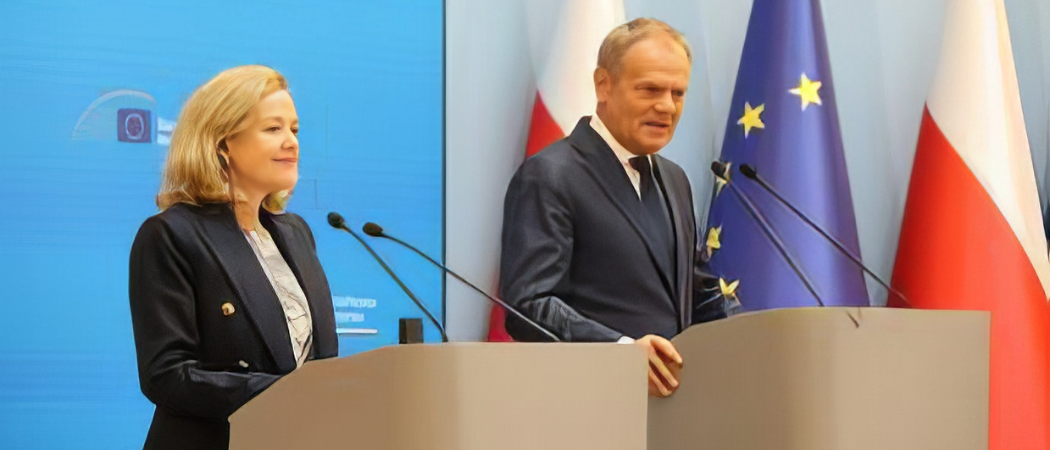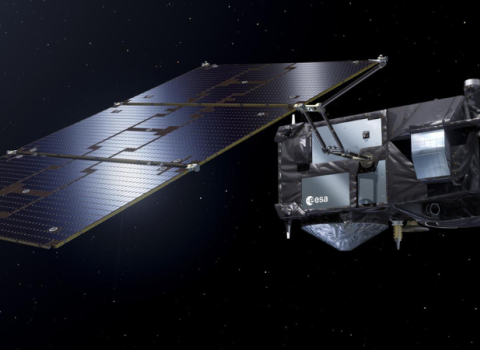Poland’s Camila constellation will boost the local ecosystem, but the impact of a parallel defence project is less certain

President of the European Investment Bank (EIB) Nadia Calviño with Polish Prime Minister Donald Tusk on a visit to the country in May. Photo: EIB
Poland is rapidly expanding its earth observation capacity, with a constellation of at least four satellites for civil use planned to launch in 2027, and of two satellites for defence and security due in 2028. The nation’s space technology ecosystem is expected to benefit from both, although questions still remain about how open the access will be to the defence project.
The Camila civilian mission will have at least four high-resolution satellites, three optoelectronic sensors and one radar. The project will be managed by the European Space Agency (ESA), with Polish companies building the satellites and managing ground operations, allowing them to gain valuable experience and knowhow.
“This expertise can then be applied to meet the country’s needs and for export purposes,” said the Polish Space Agency. “Consequently, Poland’s satellite observation capabilities will increase, enabling the creation of monitoring services based on high resolution data.” The services will be of use to sectors including agriculture, land management, and emergency situations.”
The second constellation will consist of two low earth orbit satellites providing high resolution optical imagery for both civilian and defence applications. The project will be run by the Ministry of Defence, and a contract has been agreed with Airbus to build and launch the satellites, which should be ready by 2028.
In May, the European Investment Bank (EIB) announced a €300 million loan had been agreed with the Polish Development Bank (BGK) to support the launch of the two defence satellites and construction of the ground facilities. This was one of the first investments announced by the EIB since it changed its position on dual use and security projects earlier in 2024.
The satellites will be owned and operated by Poland, providing a level of sovereignty over earth observation that is presently lacking. This is particularly important when it comes to data for defence and security.
While designed to make observations around the world, the satellites’ instruments will be designed with Polish needs in mind. This is important, for example, when it comes to monitoring the borders with Ukraine, Belarus and Russia, where instruments can now be optimised for the local ground cover and weather conditions.
Made in Poland
Of the two projects, Camila is expected to have the greatest impact on the Polish ecosystem. “The whole constellation is going to be designed, most probably, by Polish companies, so the knowhow and later the access to this data is going to be more open,” said Waldemar Franczak, chief executive of spectator.earth, a company that tracks the position of earth imaging satellites and collects their data for clients to use in applications ranging from agriculture and urban planning to renewable energy and open-source intelligence. The tracking ensures users know exactly when they can expect to have data for the location and time that interests them.
Franczak has his eye on the Camila data, but would also like spectator.earth to be involved in putting the constellation together. “Our interface can also be used by data providers, to manage their constellations and help them predict acquisition capabilities for their users,” he said.
Taking part in a large project such as this gives companies the chance to gain experience and knowhow. But it also provides access to much-needed funding, with projects on offer from a few tens of thousand euros up to millions. “Whether you are a start-up or a large, established company, there is always something you can apply for,” said Franczak. “So, an initiative like Camila will stimulate the whole space ecosystem in Poland.”
Mikołaj Podgórski, chief operating officer of optical instrument maker Scanway Space, agrees. “What we see in the US and the rest of Europe is that you need to have government oriented projects that will support the local industry and give companies a way to grow and develop new products,” he said. “We’ve not had a nationally focused activity of this kind before, so this is a good start.”
Scanway makes high resolution optical telescopes for earth observation. Later this year, one of its instruments will be launched aboard EagleEye, the largest microsatellite built to date in Poland for earth observation. Being able to participate in the Camila constellation would be a further valuable opportunity.
“So, I’m happy that Camila’s requirements are oriented towards what the Polish industry can do, rather than having to draw on competencies from abroad,” Podgórski said.
Open or closed?
The impact of the defence constellation is harder to assess. With Airbus handling the design and construction of the satellites and the ground stations, there is less of a boost here for Poland’s ecosystem, although operations are almost certain to have local impact. “Polish companies will have to be involved, because in the end everything has to stay in Poland for security reasons,” said Franczak.
The open question is how widely the data will be made available. According to the EIB, both civil and defence applications are foreseen, with data flowing to the Ministry of Defence, the Ministry of Interior and civil governmental agencies such as the Polish Space Agency.
This could have benefits for a company like spectator.earth. “Even if the data is only used by the government, that will at least mean that local authorities and other departments will have up-to-date satellite maps, and that will probably impact us as well,” Franczak said.
But what he would really like to see is the data being made more widely available, at least when not needed for security purposes. “The priority for this constellation is clearly defence and security, because that is important for us right now, but there is still plenty of room for dual-use and for others to use this data,” he said. “It’s just a matter of how the system is going to be designed.”
Data from the defence constellation would also be of interest to Marek Wilgucki, chief executive of Four Point, a start-up founded in 2018 to apply satellite surveillance to the mining industry. That ranges from supporting minerals exploration to monitoring excavation, including environmental impacts, ground movement, production infrastructure, logistics and so on.
“The mining industry is very complex, and each type of observation data is useful in a particular way. So, I’m sure the data from the new constellation would be useful to us,” Wilgucki said.
Four Point has also been exploring dual-use cases for its technology, for example adapting methods for detecting minerals beneath the ground to the detection of land mines. This is a project that it has developed with the Postup Foundation in Ukraine.
“So, this new defence satellite programme could contribute to my company, and my company could contribute to this programme,” he said. “It all depends on how the programme will be run.”
In addition to access to the data, companies will also need support to develop dual-use or security-focused applications. Taking a lead from US programmes, Wilgucki suggests $100- $200,000 as sufficient funding to work up a prototype.
“You have a lot of infrastructure on the ground to gather and process data, but then you need to do something with that data,” he said. “You need to know the use cases, what you are searching for and how you want to use it.”
Podgórski would also be interested exploring dual-use applications further. “As a small company, its beneficial to be present in both sectors,” he said.
While the present defence constellation is already contracted to Airbus, there has been discussion of a further defence system, called Microglobe, that could provide a further opportunity. “That would be similar to Camila in size and in terms of its requirements, so it could be manufactured partially or fully by Polish entities,” Podgórski said.
The difficulty is that defence procurement in Poland tends to focus on the bottom line rather than supporting the home industry, so even if Microglobe goes ahead, it would be a gamble for Polish companies to count to being involved. “There is a huge risk that a company from abroad will just step in with a technically similar piece of hardware, only delivered faster and more reliably than Polish industry can manage,” Podgórski said.
Strengthening the ecosystem
Looking at Poland’s space ecosystem as a whole, Franczak is positive about recent developments. “In the past couple of years, we’ve finally got on the right track,” he said. “I think the Polish Space Agency and the government are cooperating much better than in the past, and that is having a positive impact on the Polish space ecosystem in general.”
One gap is the kind of kickstart funding that helped spectator.earth get off the ground. “My impression is that there are fewer opportunities of this kind now, with smaller amounts of funding for prototyping, or that allows someone to focus on a particular problem for 6-12 months and try to turn it into a business,” Franczak said.
Otherwise, funding for space is bearing up, despite difficult economic conditions across the board. “There is still a lot of interest in space, comparable to domains such as AI and blockchain technologies,” Franczak said. “So, if you want to find investment, you will find it.”
Wilgucki finds Poland’s venture funds too constrained, however. Most are backed by public money, which comes with limits on how far it can be combined with other public funds. “We would like to have more private money in the market that can fill this space,” Wilgucki said.
Podgórski would like to see more support for international collaboration outside the ESA framework, for example through bilateral agreements for joint projects or scientific missions. “That is something that is missing now.”
A good example is NASA’s Artemis programme, which uses bilateral agreements to build international collaboration on human space missions. Poland signed up in 2021.
“That allows Polish companies to get a place on the race to the moon, for example, but it still requires some specific funding,” Podgórski said. “That would probably involve more money than a satellite mission, and serve a smaller number of companies, but it would still help the space industry in Poland grow.”
Elsewhere in the Ecosystem…
- The European Commission has amended its guidelines on regional state aid so that governments can put more money into investment projects covered by the Strategic Technologies for Europe Platform (STEP). This platform supports the development and manufacturing of critical technologies relevant to the EU green and digital transitions, as well as the EU's strategic sovereignty. “This will enable investments in cleantech, biotech, digital and deep tech that are key to strengthen Europe’s competitiveness, whilst preserving cohesion objectives,” said competition commissioner Margrethe Vestager.
- The European Patent Office has added a filter for space technologies to its Deep Tech Finder, which will help users to access information on European start-ups with space-related patent applications. Potential partners and investors can see the legal status of the patents of these start-ups, along with their funding history.
- Belgium has succeeded in its EU presidency goal of relaunching the European Blockchain Services Infrastructure as a European Digital Infrastructure Consortium, called Europeum. However, the project has only attracted the support of nine other EU states: Croatia, Cyprus, Greece, Italy, Luxembourg, Poland, Portugal, Romania and Slovenia. The Europeum-EDIC will support cross-border cooperation between public authorities on Web3 and decentralised technologies, promoting innovation and interoperability with other technologies.





 A unique international forum for public research organisations and companies to connect their external engagement with strategic interests around their R&D system.
A unique international forum for public research organisations and companies to connect their external engagement with strategic interests around their R&D system.